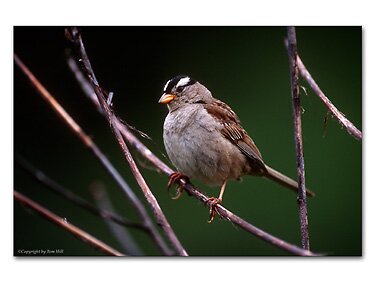

All Images And Text On This Site Are Copyright 1999-2001
by
Thomas D. Hill Jr.
| ABOUT KEIKO |
| WHAT'S NEW |
| THE KEIKO GALLERY |
| EQUIPMENT |
| IMAGE OF THE MONTH |
| ARTICLE OF THE MONTH |

16 September 2001
There's a much easier way to make a living than chasing fleeting passarines. The members of largest family of birds--the perching bird family--is characterized by their typically skittish nature and quick flights from one perch to another. For a photographer it's an extra challenging subject. Instead of carefully stalking a single individual, most photographers spend their time shooting these birds by stationing themselves near feeding stations, water stops, or any other geographical feature that may attract these kinds of birds. The goal for them is to hang out where the birds want to be. Eventually they'll end up appearing. At least that's the goal.
I've had precious little success shooting these types of birds. I have a problem with the most common sparrows let alone taking images of more rare species. It's been a frustrating experience. Perhaps I don't have the patience to hang out in a blind hoping my quarry would arrive. Perhaps I just have extra-ordinary bad karma and these critters choose to stay miles away. I don't know but I've never had much success.
This image was taken during my one period of good karma. Actually, I don't think they stayed around to have their photos taken because of my particuarly good karma. I think they just liked their bush and weren't going to retreat from it. Anytime a bird holds his position as you approach is a great sign of potentially impressive images.
This male Whitecrowned Sparrow stood his ground as I arrived with my camera equipped with a 300mm lens... 300mm's you're thinking. Why was he using a 300mm lens to take pictures of tiny birds? For those that didn't know, 300mm isn't nearly long enough to make images of little song birds. Shoot, 500mm with a 1.4x teleconverter isn't long enough most of the time. Rarely with a 300mm have I made acceptable bird images and the few times I have were because of very special circumstances. I've had some success with fairly large raptors such as Great Grey Owls and such. But, even then using a 300mm is a bit like tying one arm behind your back in a boxing match. Other, longer lenses are simply better tools in most circumstances. I normally wouldn't recommend a 300mm has a primary bird lens. But, as you see here you can have some success with it.
Why was I using my 300mm f/2.8 AF-S? Because it's small and very manueverable compared to my 500mm f/4 AF-S. The 300mm weighs less than half the 500mm. It's less than half as long which makes it much easier to use on a monopod. In all respects, my 300mm f/2.8 AF-S is simpler to use than the 500mm. Those characteristics are especially important when schelping camera equipment during morning walks just like the situation for this month's image. I had taken a couple rolls of film earlier in the morning of other resident birds using my 500mm. None of those images worked out as well as this Whitecrowned Sparrow.
My technique for shooting birds includes lots of slow approaches. That usually means I identify my quary then slowly get near. The technique can be painfully slow and movements are only made when the subject appears to accept my presence. Unfortunately 99% of the time I reach a point where all birds take off regardless of my technique. Hopefully by that time the lens I'm using was sufficient for getting real closeups. As I noted before, the 300mm is usually insufficient for small bird photography and most of the time I won't even try. Well, for this image I decided to try.
I walking with only my 300mm f/2.8 AF-S, TC-14e, F5, and Gitzo Monopod. I didn't have anything else. The walk wasn't intended to be that productive or I may have brought at least an extra roll of film. I was just out for a short Sunday stoll. I spied these Sparrows in a small bush and decided to practice my approach techniques. Little did I realize how the morning would materialize. They were extremely cooperative and allowed a very close approach. This image was the last of my modest film supply--that one roll--which happened to be taken at the lens' min-focus distance. It all seemed to work out.
Cheers,
Tom